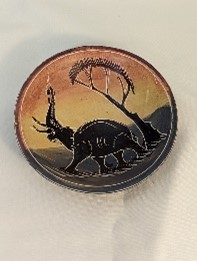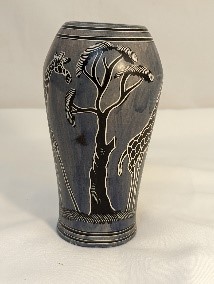Traditionally, the African cultures known as the Kisii have long mined soapstone from the Tabaka Hills in southwest Kenya to make powdered soapstone for use in healing, divining, and initiation rituals. Starting in the 20th century, Kisii men began to mine this soft metamorphic rock in order to supply workshops where the soapstone is carved into small sculptures and household objects such as vases, candle holders, and curios to sell in the tourist trade. The manufacture of these objects has brought greatly needed financial support into this region.


Before (above) and After (below) Conservation
Candle Holder with Design of Repeating Squares
Kisii culture
20th century
Soapstone and pigment
L. 5.6 cm x W. 5.4 cm x H. 15.5 cm
African and African American Studies collection #2022.7


Before (above) and After (below) Conservation
Candle Holder with Images of Dancing Figure and Drum
Kisii culture
20th century
Soapstone and pigment
L. 6.2 cm x W. 6.2 cm x H. 15.3 cm
African and African American Studies collection #2022.2
The Kisii soapstone objects are created in workshops in a production-line format that employs both men and women. Typically, men workers serve as the primary artisans, carving the soapstone into shapes using axes, knives, and chisels, and women workers then sand the forms smooth and wash them. Next, the men use knives or chisels to etch the objects with geometric designs and details or with freehand motifs that reflect their traditional cultures, such as motifs of plants and animals of the savannah. They may also add paint in contrasting colors. Finally, the women finish the sculptures by waxing them and boxing them for transport.


Before (above) and After (below) Conservation
Box with Image of an Elephant, a Carved Frog, and a Carved Snake
Kisii culture
20th century
Soapstone and pigment
L. 6 cm x W. 3.8 cm x H. 6.2 cm
African and African American Studies collection collection #2022.3
Today the production of soapstone objects has become a tradition among the Kisii, and the skills for making these objects are passed down in families and are taught in the high schools. This artform helps to ensure the continued financial viability of Kisii communities, using their available local resources.

After Conservation
Bowl with Image of an Elephant on the Savanna
Kisii culture
20th century
Soapstone and pigment
L. 12.6 cm x W. 12.6 cm x H. 2.8 cm
African and African American Studies collection #2022.5

After Conservation
Vase with an Image of a Giraffe on the Savanna
Kisii culture
20th century
Soapstone and pigment
L. 8.2 cm x W. 7.2 cm x H. 15.9 cm.
African and African American Studies collection #2022.6
For more information, you may contact the researcher(s) noted in the title of this exhibit entry, or Dr. Billie Follensbee, the professor of the course, at BillieFollensbee@MissouriState.edu
